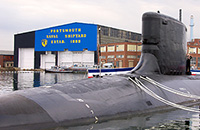Portsmouth Naval Shipyard
Portsmouth Naval Shipyard (PNS) is one of four active naval shipyards remaining in the U.S. Established more than three centuries ago, PNS was commissioned by the federal government in 1800 and launched its first warship, USS Washington, in 1815.

Submarines built and taken care of at Portsmouth contained a lot of asbestos. Although they stopped using asbestos-containing products in the middle of the 1970s, people who worked there are at risk of mesothelioma.
In 1969, the yard finished building and sending off its last submarine. Now it’s used to fix up, keep in shape and fill up fuel for the Navy’s submarines.
Sailors have a higher chance of getting cancer from asbestos. The International Journal of Environmental Health Research published a review on this topic. It showed that seafarers from five Nordic countries were twice as likely to get mesothelioma than the average person.
Asbestos Use at Portsmouth Naval Shipyard
Employees at the Portsmouth Naval Shipyard had contact with asbestos fibers in many different ways. Asbestos insulation was used a lot, not only on ships and submarines, but also inside of 376 buildings that take up two-thirds of the shipyard’s space.
Asbestos was discovered, for example, during the excavation of Building 310, a hose-handling facility built in 1980. From 1994 to 1995, excavation work near temporary housing revealed asbestos cloth.
Asbestos also coated the boilers and water pipes of both buildings and vessels on site. Gear from PNS also included asbestos. Aprons, gloves, thermal curtains and blankets contained asbestos.
Poor safety controls at PNS contributed to the extent of workplace exposure to asbestos. Documents suggest that up until the mid-1970s, ventilation was either ineffective or absent.

Learn about your diagnosis, top doctors and how to pay for treatment.
Get Your Free GuideNIOSH Investigates Asbestos Contamination at PNS
A 1978 cohort study conducted at PNS indicated high death rates for all cancers, prompting the National Institute for Occupational Safety and Health (NIOSH) to further investigate the extent of past exposures that occurred there.
NIOSH constructed a database containing 2,558 asbestos samples collected from the 1940s to the 1990s and consulted a three-person industrial hygiene panel. Each of the panelists had at least 25 years of experience with the working conditions and past exposures at PNS from the 1970s to the 1990s.
In the order of intensity, the most asbestos-exposed positions at Portsmouth Naval Shipyard were pipefitters, welders, electricians and sheet metal mechanics. An analysis of the top 10 asbestos-exposed jobs at the shipyard revealed that 19% of the workers studied held at least one of these positions.
Out of the 4,388 subjects studied, nearly 64% were exposed to levels of asbestos above the pre-determined background intensity level of 0.004 fibers per cubic centimeter while working at PNS. Because there is no safe level of asbestos exposure, significant disease could have still occurred in workers with the lowest levels of exposure.
Asbestos Lawsuits
Although the Navy is shielded from liability by the Federal Employee’s Compensation Act, former workers exposed to asbestos at Portsmouth Naval Shipyard have sought compensation and punitive damages from asbestos manufacturers who failed to warn about the toxicity of their products.
In one consolidated case known as the All Maine Asbestos Litigation, dozens of former workers from PNS and Bath Iron Works filed suit against 26 asbestos product manufacturers and distributors. The plaintiffs claimed these companies’ negligence led to occupational diseases and wrongful deaths.
Another lawsuit filed against four asbestos manufacturers was settled for $512,000. In this case, the daughter of a former Portsmouth Naval Shipyard pipe insulator died of mesothelioma after secondary asbestos exposure. The fibers were carried home on her father’s work clothes.
Recommended Reading


